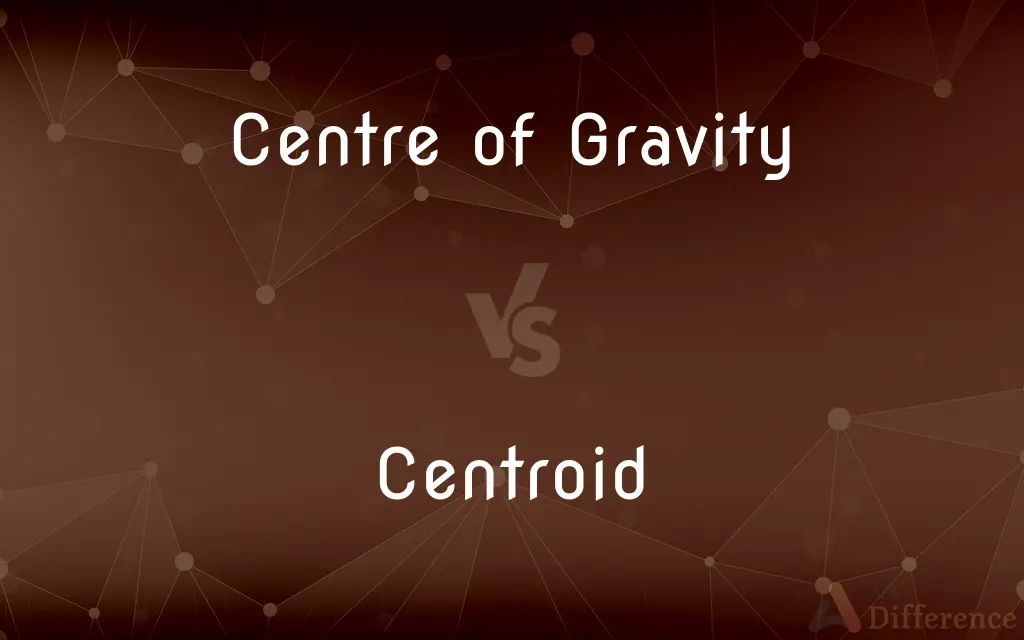Centre of Gravity vs. Centroid — What's the Difference?
By Tayyaba Rehman — Published on November 4, 2023
The Centre of Gravity is a point where an object's weight is balanced, while the Centroid is the geometric center of a shape.

Difference Between Centre of Gravity and Centroid
Table of Contents
ADVERTISEMENT
Key Differences
The Centre of Gravity is a fundamental concept in physics and refers to the single point in an object where the force of gravity can be considered to act. It represents the average location of the weight of an object. In uniform gravitational fields, like on Earth's surface, the Centre of Gravity is typically at the same location as the object's center of mass.
The Centroid, conversely, is a purely geometric concept. It is the center of a two-dimensional shape, a point that defines the geometric average of all points in the shape. For regular, symmetrical shapes, the Centroid is easily identified, as it sits at the shape's geometric center. For irregular shapes, the Centroid may not be as intuitive.
It's essential to recognize that while the Centre of Gravity is influenced by gravity and mass distribution, the Centroid is independent of these factors. The Centroid only considers the shape and its geometry. However, for homogenous materials, the Centre of Gravity and the Centroid coincide.
The distinction is significant, especially in engineering and design. Knowing where the Centre of Gravity is can help determine an object's stability, while understanding the Centroid's position can aid in design processes, such as determining stress and strain in materials.
In some scenarios, especially when dealing with flat, uniform materials, the terms might be used interchangeably. Yet, when diving deep into mechanics and structural engineering, the differences between Centre of Gravity and Centroid become crucial.
ADVERTISEMENT
Comparison Chart
Nature
Physical concept
Geometric concept
Depends on
Mass distribution and gravity
Geometry of the shape
Represents
Point where weight is balanced
Geometric center of a shape
Influence
Influenced by gravity
Independent of mass and gravity
Application
Used in stability and balance analyses
Used in geometry and some structural engineering contexts
Compare with Definitions
Centre of Gravity
Point where total weight acts.
The bus tipped over because its Centre of Gravity shifted.
Centroid
Average of all points in a shape.
For a square, the Centroid lies where its diagonals intersect.
Centre of Gravity
Influenced by gravitational force.
On the moon, the Centre of Gravity of an object remains the same, but weight changes.
Centroid
Geometric center of a shape.
The triangle's Centroid is also its balancing point.
Centre of Gravity
Represents balance of an object.
The Centre of Gravity of this sculpture is carefully positioned at its base.
Centroid
Found using coordinate geometry.
The Centroid of a region can be found using integrals in calculus.
Centre of Gravity
Dependent on mass distribution.
By redistributing the cargo, the ship's Centre of Gravity was lowered.
Centroid
See center of mass.
Centre of Gravity
Crucial in stability analysis.
Engineers consider the Centre of Gravity when designing vehicles for safety.
Centroid
The point in a system of masses whose coordinates on each dimension are a weighted mean of the coordinates of points on that dimension, the weights being determined by the density function of the system.
Centroid
The point at which gravitational force (or other universally and uniformly acting force) may be supposed to act on a given rigid, uniformly dense body; the centre of gravity or centre of mass.
Centroid
The point of intersection of the three medians of a given triangle; the point whose (Cartesian) coordinates are the arithmetic mean of the coordinates of the three vertices.
Centroid
(of a finite set of points) the point whose (Cartesian) coordinates are the arithmetic mean of the coordinates of a given finite set of points.
Centroid
An analogue of the centre of gravity of a nonuniform body in which local density is replaced by a specified function (which can take negative values) and the place of the body's shape is taken by the function's domain.
The centroid of an arbitrary function is given by , where the integrals are calculated over the domain of .
Centroid
The arithmetic mean (alternatively, median) position of a cluster of points in a coordinate system based on some application-dependent measure of distance.
Centroid
Given a tree of n nodes, either (1) a unique node whose removal would split the tree into subtrees of fewer than n/2 nodes, or (2) either of a pair of adjacent nodes such that removal of the edge connecting them would split the tree into two subtrees of exactly n/2 nodes.
Centroid
The center of mass, inertia, or gravity of a body or system of bodies.
Centroid
The center of mass of an object of uniform density
Centroid
Used in geometry and engineering.
To determine stress distribution, engineers often refer to the Centroid.
Centroid
Independent of gravity and mass.
Regardless of material, the Centroid of a given shape remains constant.
Common Curiosities
Do the Centre of Gravity and Centroid always coincide?
For uniform, flat objects they do, but not always for irregular objects.
Is the Centroid influenced by the material of the shape?
No, the Centroid is purely a geometric concept.
Why is the Centre of Gravity important in vehicles?
It helps determine stability, especially during motion.
How is the Centroid used in engineering?
It's crucial for determining stress, strain, and moments in materials.
Is the Centroid always inside the shape?
For continuous, solid shapes, yes. But it can be outside for certain composite shapes.
Does the Centroid change if the shape is modified?
Yes, altering the shape will change its Centroid.
Is Centre of Gravity essential for aircraft design?
Absolutely, it impacts balance, stability, and flight dynamics.
What happens to the Centre of Gravity if weight is added to an object?
It shifts towards the additional weight.
Can the Centre of Gravity be outside the object?
Yes, it can be, especially in objects with unusual shapes.
Can the Centroid and Centre of Gravity be at the same point?
Yes, especially in homogenous objects.
How can one find the Centre of Gravity of irregular objects?
Through experimentation or detailed mass distribution analysis.
Why is the Centroid significant in geometry?
It helps in various calculations, such as area and moment calculations.
Is the Centre of Gravity affected by orientation?
No, but its perceived position might change due to the object's orientation.
How is the Centroid found mathematically?
Using integrals in coordinate geometry.
Can both concepts be applied to 3D objects?
Yes, both can be extended to three-dimensional objects.
Share Your Discovery

Previous Comparison
Fish vs. Reptiles
Next Comparison
X86 vs. X64Author Spotlight
Written by
Tayyaba RehmanTayyaba Rehman is a distinguished writer, currently serving as a primary contributor to askdifference.com. As a researcher in semantics and etymology, Tayyaba's passion for the complexity of languages and their distinctions has found a perfect home on the platform. Tayyaba delves into the intricacies of language, distinguishing between commonly confused words and phrases, thereby providing clarity for readers worldwide.
















































